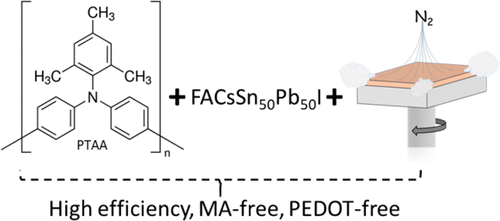当前位置:
X-MOL 学术
›
ACS Energy Lett.
›
论文详情
Our official English website, www.x-mol.net, welcomes your feedback! (Note: you will need to create a separate account there.)
Improving Low-Bandgap Tin–Lead Perovskite Solar Cells via Contact Engineering and Gas Quench Processing
ACS Energy Letters ( IF 22.0 ) Pub Date : 2020-03-17 , DOI: 10.1021/acsenergylett.0c00255 Jérémie Werner 1, 2 , Taylor Moot 2 , Tyler A. Gossett 1, 2 , Isaac E. Gould 2, 3 , Axel F. Palmstrom 2 , Eli J. Wolf 2, 4 , Caleb C. Boyd 2, 4 , Maikel F. A. M. van Hest 2 , Joseph M. Luther 2 , Joseph J. Berry 2 , Michael D. McGehee 1, 2, 3
ACS Energy Letters ( IF 22.0 ) Pub Date : 2020-03-17 , DOI: 10.1021/acsenergylett.0c00255 Jérémie Werner 1, 2 , Taylor Moot 2 , Tyler A. Gossett 1, 2 , Isaac E. Gould 2, 3 , Axel F. Palmstrom 2 , Eli J. Wolf 2, 4 , Caleb C. Boyd 2, 4 , Maikel F. A. M. van Hest 2 , Joseph M. Luther 2 , Joseph J. Berry 2 , Michael D. McGehee 1, 2, 3
Affiliation

|
Low-bandgap Sn/Pb ABX3 perovskites have reached photovoltaic power conversion efficiencies >20%, but they usually have poor stability due to the common use of acidic poly(3,4-ethylenedioxythiophene):polystyrenesulfonate (PEDOT:PSS) hole transport layers and A-site cation compositions containing methylammonium (MA). Here, we develop a process to enable high-quality MA-free Sn/Pb perovskite films grown using a gas quenching process instead of the conventional antisolvents, which provides improved control of the film growth and eliminates wrinkling. Using this method in a device structure with poly[bis(4-phenyl)(2,4,6-trimethylphenyl)amine] (PTAA) instead of PEDOT:PSS as the hole transport layer, devices can reach efficiencies up to 20%mppt at 0.06 cm2 and up to 17.5%mppt at 1 cm2 active area. With these improvements, the devices are characterized for thermal stability and show 80% of the initial power output remaining after 4000 h at 85 °C.
中文翻译:

通过接触工程和气体淬火工艺改进低带隙的锡铅钙钛矿太阳能电池
低带隙Sn / Pb ABX 3钙钛矿的光电转换效率达到> 20%,但是由于通常使用酸性聚(3,4-乙撑二氧噻吩):聚苯乙烯磺酸盐(PEDOT:PSS)空穴传输层,因此它们的稳定性通常较差以及含有甲基铵(MA)的A-位阳离子组合物。在这里,我们开发了一种方法,该方法可实现使用气体淬火工艺代替传统的抗溶剂生长的高质量无MA锡/铅钙钛矿膜,从而改善了对膜生长的控制并消除了皱纹。在以聚[双(4-苯基)(2,4,6-三甲基苯基)胺](PTAA)代替PEDOT:PSS作为空穴传输层的器件结构中使用此方法,器件可以达到高达20%mppt的效率在0.06厘米2在1 cm 2的有效面积上最高可达mppt的17.5%。通过这些改进,这些器件具有热稳定性,并且在85°C下经过4000小时后仍显示80%的初始功率输出。
更新日期:2020-04-23
中文翻译:

通过接触工程和气体淬火工艺改进低带隙的锡铅钙钛矿太阳能电池
低带隙Sn / Pb ABX 3钙钛矿的光电转换效率达到> 20%,但是由于通常使用酸性聚(3,4-乙撑二氧噻吩):聚苯乙烯磺酸盐(PEDOT:PSS)空穴传输层,因此它们的稳定性通常较差以及含有甲基铵(MA)的A-位阳离子组合物。在这里,我们开发了一种方法,该方法可实现使用气体淬火工艺代替传统的抗溶剂生长的高质量无MA锡/铅钙钛矿膜,从而改善了对膜生长的控制并消除了皱纹。在以聚[双(4-苯基)(2,4,6-三甲基苯基)胺](PTAA)代替PEDOT:PSS作为空穴传输层的器件结构中使用此方法,器件可以达到高达20%mppt的效率在0.06厘米2在1 cm 2的有效面积上最高可达mppt的17.5%。通过这些改进,这些器件具有热稳定性,并且在85°C下经过4000小时后仍显示80%的初始功率输出。



























 京公网安备 11010802027423号
京公网安备 11010802027423号